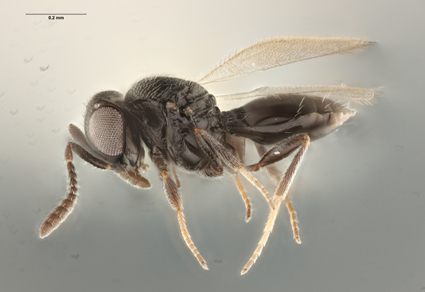Abstract
A collection of egg parasitoids in the Scelionidae are identified as members of the Telenomus californicus Ashmead, 1893 complex (californicus+dalmanni+arzamae groups). They were reared from eggs of the cactus zebra worm, Melitara cf. junctoliniella Hulst, 1900 (Pyralidae: Phycitinae) infesting Opuntia streptacantha Lemaire, 1839 (Cactaceae) at Bustamante, Nuevo León, Mexico. Lacking both male specimens and a revision of the complex, no species-level identification could be made. The taxonomic placement of these wasps is discussed as well as possible implementation of these egg parasitoids in new-association biological control of the invasive cactus moth Cactoblastis cactorum (Berg, 1885) (Pyralidae: Phycitinae) in North America.
References
- Eilenberg, J., Hajek, A. & Lomer, C. (2001) Suggestions for unifying the terminology in biological control. BioControl, 46, 387–400. https://doi.org/10.1023/A:1014193329979
- Felipe-Victoriano, M., Talamas, E.J. & Sánchez-Peña, S.R. (2019) Scelionidae (Hymenoptera) parasitizing eggs of Bagrada hilaris (Hemiptera, Pentatomidae) in Mexico. In: Talamas, E. (Ed.), Advances in the Systematics of Platygastroidea II. Journal of Hymenoptera Research, 73, pp. 143–152. https://doi.org/10.3897/jhr.73.36654
- Fernández-Triana, J.L., Cardinal, S., Whitfield, J.B., Hallwachs, W., Smith, M.A. & Janzen, D.H. (2013) A review of the New World species of the parasitoid wasp Iconella (Hymenoptera, Braconidae, Microgastrinae). ZooKeys, 321, 65–87. https://doi.org/10.3897/zookeys.321.5160
- Fortes, A.D.R., Coelho Jr., A., Amorim, D.J., Demetrio, C.G. & Parra, J.R. (2023) Biology and quality assessment of Telenomus remus (Hymenoptera: Scelionidae) and Trichogramma spp. (Hymenoptera: Trichogrammatidae) in eggs of Spodoptera spp. for augmentative biological control programs. Journal of Insect Science, 23 (5), 5. https://doi.org/10.1093/jisesa/iead047
- Heimpel, G.E., Abram, P.K. & Brodeur, J. (2021) A phylogenetic perspective on parasitoid host ranges with implications for biological control. Current Opinion in Insect Science, 44, 95–100. https://doi.org/10.1016/j.cois.2021.04.003
- Hight, S.D., Carpenter, J.E., Bloem, K.A., Bloem, S., Pemberton, R.W. & Stiling, P. (2002) Expanding geographical range of Cactoblastis cactorum (Lepidoptera: Pyralidae) in North America. Florida Entomologist, 85, 527–529. https://doi.org/10.1653/0015-4040(2002)085[0527:EGROCC]2.0.CO;2
- Hokkanen, H.M. & Pimentel, D. (1989) New associations in biological control: theory and practice. The Canadian Entomologist, 121, 829–840. https://doi.org/10.4039/Ent121829-10
- Johnson, N.F. (1984) Systematics of Nearctic Telenomus: classification and revisions of the podisi and phymatae species groups (Hymenoptera: Scelionidae). Bulletin of the Ohio Biological Survey, New Series, 6 (3), 1–113.
- Mahr, D.L. (2001) Cactoblastis cactorum (Lepidoptera: Pyralidae) in North America: a workshop of assessment and planning. Florida Entomologist, 84, 465–473. https://doi.org/10.2307/3496373
- Mann, J. (1969) Cactus-feeding insects and mites. Smithsonian Institute Bulletin 256. Smithsonian Institute, Washington, D.C., 158 pp. https://doi.org/10.5479/si.03629236.256.1
- Martínez, J.J., Berta, C., Varone, L., Logarzo, G., Zamudio, P., Zaldívar-Riverón, A. & Aguilar-Velasco, R.G. (2012) DNA barcoding and morphological identification of Argentine species of Apanteles (Hymenoptera: Braconidae), parasitoids of cactus-feeding moths (Lepidoptera: Pyralidae: Phycitinae), with description of a new species. Invertebrate Systematics, 26 (6), 435–444. https://doi.org/10.1071/IS12060
- Morales-Gálvez, M., Villegas-Luján, R., Plowes, R., Gilbert, L., Matson, T., Gallegos-Morales, G. & Sanchez-Peña, S. (2022) Natural egg parasitism by Scelionidae on a Phycitine cactus moth in Mexico. Florida Entomologist, 105, 174–177. https://doi.org/10.1653/024.105.0212
- Morrison, C.R., Plowes, R.M., Jones, N.T. & Gilbert, L.E. (2021) Host quality does not matter to native or invasive cactus moth larvae: grave implications for North American prickly pears. Ecological Entomology, 46, 319–333. https://doi.org/10.1111/een.12964
- Soberón, J., Golubov, J. & Sarukhán, J. (2001) The importance of Opuntia in Mexico and routes of invasion and impact of Cactoblastis cactorum (Lepidoptera: Pyralidae). Florida Entomologist, 84, 486–492. https://doi.org/10.2307/3496376
- Villegas-Luján, R., Plowes, R., Gilbert, L.E., Rodríguez, J.C., Canales-del-Castillo, R., Gallegos-Morales, G., España-Luna, M.P., Fernández-Triana, J. & Sanchez-Peña, S.R. (2024) Redescription of Apanteles mimoristae (Hymenoptera, Braconidae), a parasitoid of the native pyralid cactus moth Melitara cf. nephelepasa in central Mexico. Journal of Hymenoptera Research, 97, 207–228. https://doi.org/10.3897/jhr.97.117514


